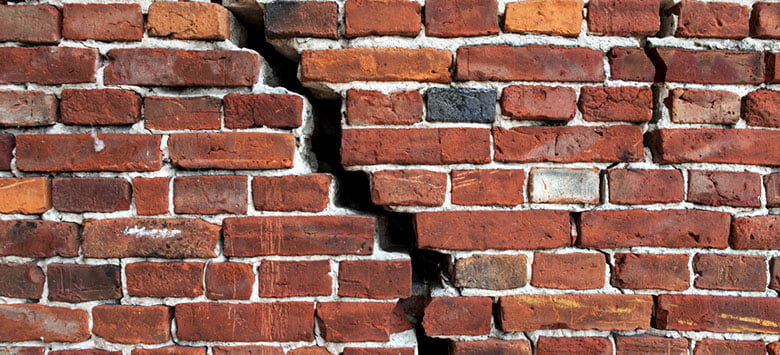
Introduction
Buildings and other built structures are moving all the time, but usually these movements are so small as to be unnoticeable. Movement can be caused by defects, movement of the ground, foundation failure, decay of the building fabric, and so on.
If a structure is unable to accommodate this movement, cracking is likely to occur. The appearance of distortions and cracks can be visually unattractive and disconcerting for occupants, and if left untreated they can affect the integrity, safety and stability of the structure.
Effective treatment requires first that the causes of cracking are understood. Only then can a strategy for repair be implemented.
Causes of cracks
The most common causes of cracking are:
§ Ground movement (beneath foundations) caused by clay shrinkage, land slip, vibration, subsidence, settlement, heave, sway, and so on.
§ Foundation failure due to the decay of soft clay brick, concrete erosion due to chemical contaminants, and so on.
§ Decay of the building fabric, due to woodworm, rust, and so on.
§ Moisture movement that causes materials to expand or contract, perhaps due to the presence of vegetation or faulty or damaged drains.
§ Thermal movement that causes materials to expand or contract as temperature increases or decreases.
§ Inherent defects, particularly in historic structures.
§ Faulty or damaged drains.
§ Suspended structures such as floors that deform under load.
§ Tree root growth.
§ Absence of foundations in older buildings.
Size of cracks
BRE assessed a number of properties as part of a study that was published as BRE Digest 251 Assessment of damage in low-rise buildings. This identified six categories of cracks together with the typical damage caused and the remedy required:
§ 0 – Hairline cracks: Less than 0.1 mm in width. No repair action required.
§ 1 – Fine cracks: Up to 1 mm in width. Generally restricted to internal wall finishes. Easily treated using normal decoration.
§ 2 – Cracks easily filled: Up to 5 mm in width. Not necessarily visible externally, but doors and windows may require adjusting to prevent sticking. Can be masked by suitable linings.
§ 3 – Cracks that require opening up: Widths of 5-15 mm. Weather-tightness and service pipes may be affected. External brickwork may need repointing or, in some cases, to be replaced.
§ 4 – Extensive damage: Widths of 15-25 mm. Windows and door frames become distorted, walls lean or bulge noticeably. Requires breaking-out and replacement of wall sections.
§ 5 – Structural damage: Widths greater than 25 mm. Beams lose their bearing, walls require shoring, and the structure is generally unstable. May require major repair works.
Shapes of cracks
§ Hairline cracks are common in many buildings, particularly in plaster, which is prone to shrink and is very sensitive to movement.
§ Stepped cracks tend to follow the lines of horizontal and vertical joints in buildings, such as beds of mortar between bricks or blocks and may indicate structural movement.
§ Vertical cracks may indicate that structural components such as bricks or blocks have failed and so can be a sign of significant stresses within the building structure.
§ Cracks that are wider at the top or at the bottom may indicate that there has been foundation movement, with the direction of the widening giving an indication of the likely direction of the movement.
§ Horizontal cracks may indicate that an element such as a wall is failing and this may present a safety concern.

Dealing with cracks
Designers of new buildings may try to ‘design out’ many of the causes that may lead to cracking by careful design of the foundations and superstructure, introducing movement joints, specifying materials that can tolerate movement, and so on.
Existing buildings should be examined for the likely cause of movement, and whether this is due to an external factor (such as subsidence), or is caused by the fabric of the building itself (such as a poor grade of cement). It is important to establish whether the cracking is likely to be progressive and to deteriorate further, and if so, to what extent and over what period of time. Research of archival information, such as previous surveys, can help with this assessment.
Repair strategies can range from major interventions to limited cosmetic works. However, unless the underlying cause has been dealt with, it is likely that further maintenance work will be required in the future. Movement caused for example by vibration or by thermal expansion and contraction is likely to persist. In this case, repair materials must be chosen carefully; those with the ability to deform in a plastic manner will be more successful than those that simply increase strain around the crack and so are likely to cause the repair to fail.
For example, hydraulic or fat limes may provide enough plasticity to accommodate strain. Corrosion-resistant stainless steel reinforcements can be inserted into bed joints to reduce the risk of failure by redistributing strain and stress over a wider area.
Instruments such as boroscopes can be used to locate voids that may have opened up as a result of movement. Grouting voids to fill them with cementitious material can provide a solution if the underlying cause has been dealt with.
Where underpinning of foundations is required, a number of alternative techniques are available. See underpinning for more information.
Rather than simply covering up problems, it is important to understand the reason that cracks have occurred, particularly if they are large, or if they are increasing in size, and it may be wise to seek expert advice.



Comments are closed